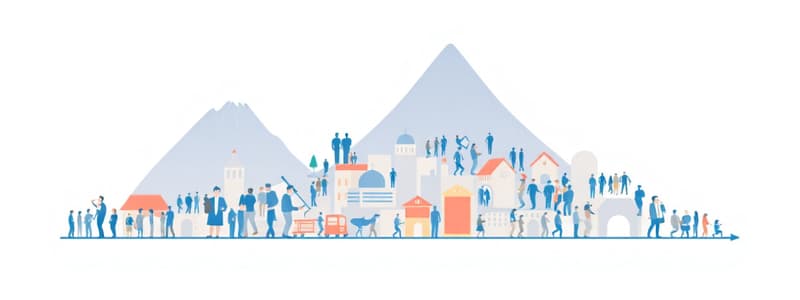Podcast
Questions and Answers
What does the width of the population pyramid represent?
What does the width of the population pyramid represent?
- The number of newborns only
- The age distribution of the population (correct)
- The gender ratio in the population
- The mortality rate of the population
Which trend is observed between the population pyramids of 1950 and 2018?
Which trend is observed between the population pyramids of 1950 and 2018?
- Child mortality rates decreased (correct)
- The number of births decreased in 2018
- The total global population remained the same
- The population of older age groups increased significantly
What is projected for the global population by the end of the century?
What is projected for the global population by the end of the century?
- A population of around 10.4 billion (correct)
- A population of around 12 billion
- A population that mirrors the structure of 1950
- A decrease in the global population
In 1950, what was the main characteristic of the population pyramid?
In 1950, what was the main characteristic of the population pyramid?
What can be inferred about the base of the population pyramid projected for 2100?
What can be inferred about the base of the population pyramid projected for 2100?
By how much did the number of children born change from 1950 to 2018?
By how much did the number of children born change from 1950 to 2018?
What demographic structure does a population pyramid with high mortality rates resemble?
What demographic structure does a population pyramid with high mortality rates resemble?
What was the primary cause of the increase in world population between 1950 and today?
What was the primary cause of the increase in world population between 1950 and today?
What demographic change is expected to occur as child populations start to decline?
What demographic change is expected to occur as child populations start to decline?
Which countries are expected to benefit from the demographic dividend in the coming decades?
Which countries are expected to benefit from the demographic dividend in the coming decades?
Flashcards are hidden until you start studying
Study Notes
Global Population Growth
- The global population has increased drastically from 2.5 billion in 1950 to over 8 Billion currently and is expected to reach around 10.4 billion by the end of the 21st century
- Population Pyramids are used to visualize the distribution of a population by age and gender
- The shape of population pyramids can provide insights into demographics and the health of a population.
- In 1950, the pyramid had a wide base due to high birth rates and a narrow top due to high death rates
- The child mortality rate is declining and the pyramid is becoming less narrow above the base.
- The number of children born has increased since 1950, and the mortality of children has decreased at the same time.
- While the number of children born will increase slightly then decline, the number of people of working age and old age will increase significantly.
- There will be fewer children born by the end of the century than today.
- The base of the population pyramid for 2100 is projected to be narrower than the one in 2018.
Demographic Dividend
- In the coming decades, poorer countries will benefit from a "demographic dividend," where the share of the working population increases.
Population Health
- The global population is becoming healthier and the proportion of older people is increasing.
- A more box-shaped population pyramid reflects a healthier population with a low death rate during younger ages.
Global Population Trends
- The global population is expected to become more box shaped by 2100, indicating a healthier population with a low death rate and an aging population.
- From 1950 to today, the global population growth was a widening of the entire pyramid, with an increase in the number of children.
- In the future, global population growth will be characterized by a 'fill up' of the population, with a lesser increase in the number of children followed by a decline, but a significant increase in the proportion of people of working age and old age.
- This shift is driven by decreasing death rates and improved global health leading to longer life expectancies.
Studying That Suits You
Use AI to generate personalized quizzes and flashcards to suit your learning preferences.



